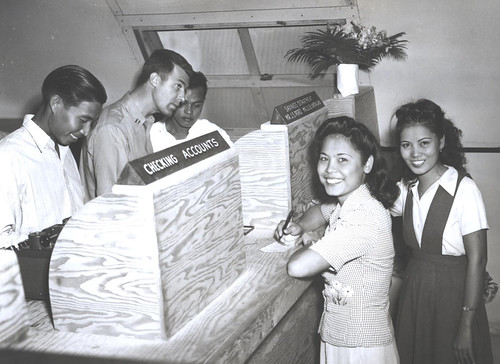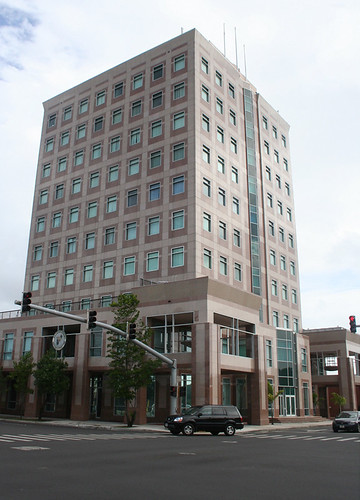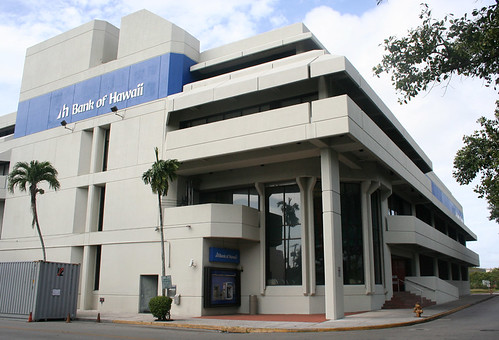Concessionary Era
Guam’s banking history began during what is known in the banking world as the Pacific’s Concessionary Era that ran from 1900 to 1945.
In December 1915, Guam Governor William J. Maxwell (1914 – 1916) established the Bank of Guam as a US government entity. The bank opened with a reserve of $15,000 in gold. It served the island until 1941 when it was forced to cease operations due to World War II. The Japanese invaded Guam, taking over the island from the Americans.
It is reported that no banks existed during the Japanese occupation. In the Japanese-mandated islands, post offices served the population with limited banking services.
The Concessionary Era was termed a “transitional period,” encompassing two world wars. Banking expansion in the rest of the Pacific almost came to a standstill after World War I (1914-1918) with the sole exception of banks from Australia and New Zealand which ventured into the former German-administered islands of New Guinea and Samoa.
National Era
The National Era (1945 – 1975) following World War II was characterized as a period of decolonization, nationalism, and state-led industrialization. It was also marked as a time of stigmatization of private and multinational firms. Governments in the Pacific islands encouraged production for local needs and imposed tariff walls and licensing frameworks that hindered efficiency and the entrepreneurial spirit.
In war weary Guam, the Bank of Guam reopened under Navy management on 15 March 1945. At the time, it was the only bank authorized to operate in Guam. Spurred on by the post-war boom, the bank become so successful that it opened a branch in the neighboring island of Saipan in 1947.
True to the times, the Organic Act of Guam was passed in 1950 and ushered in an era of gradual decolonization. With the transfer of the island’s administration from the US Navy Department to the US Department of Interior, the Bank of Guam was sold to the Bank of America that same year.
Four years later, Joseph Flores, a prominent Guam businessman and civic leader, founded the first locally-owned financial institution in Guam, Guam Savings and Loan. It opened for business on 7 July 1954 and would eventually grow into what is today BankPacific.
The post-war years were a time of major change in the island. Flores became the first Governor of Guam of CHamoru descent in 1960 (not including the interim years between the Spanish and US Naval eras.) During his administration, the Bank of Hawai’i was licensed to operate in Guam in direct competition with the Bank of America. This opened the door for other US financial institutions. Citibank entered the market in 1969 followed by First Hawaiian Bank in 1970 and Chase Manhattan in 1972.
Several prominent local families and a group of visionary government employees established financial institutions during this period. In 1959 Paul Bordallo, a former employee of Guam Savings and Loan, founded Family Finance. Then in 1962, 20 government employees led by Speaker Joe T. San Agustin donated a total of $250 to establish the Government of Guam Federal Credit Union.
But it wasn’t until 1972 when Jesus Sablan Leon Guerrero, a former Bank of America Vice President, realized a lifelong dream with the establishment of Guam’s first locally chartered full service bank, the Bank of Guam. Leon Guerrero along with co-founder, Jose LG Untalan, established the bank to fill a need they saw in the banking services provided to the local Guam community. The Bank of Guam would realize tremendous success in the years to come and be at the vanguard of the banking industry.
In 1974, two other US-based banks would enter the Guam market, Union Bank of California and the Bank of Tokyo of California.
International Era
The International Era (1975 – present) characterized by increasing openness to foreign banks, saw a slew of foreign banks initially rush to enter the Guam market from the fringes or outside the Pacific.
The first Philippine bank to enter the market, Metropolitan Bank and Trust, opened a Guam branch in 1975 to service the Filipino-Chinese community. Allied Bank, another Philippine bank, opened in 1977 with a wholesale branch in Guam. It also owned Oceanic Bank, another Philippine bank that opened a branch in Guam.
HSBC opened in Guam in 1976 followed by Taiwan’s First Commercial Bank in 1977. In 1989, Saitama Bank opened a financial unit to service development projects in Guam and the Northern Marianas. Saitama Bank was Japan’s first direct entry into the Guam market.
Several of the existing banks expanded operations in Guam during the early period of this era.
In 1979 Bank of Hawai’i’s parent company, Hawaii Bancorporation, Inc. opened Bankoh Finance, an industrial loan company in Hagåtña, Guam’s capital. Then in 1986, the International Banking Group, consisting of Chinese Marketing Group and Korean Marketing Group, are established by Bank of Hawaii to facilitate foreign investments.
Three years later Bancorporation Inc. opened Hawaiian Trust Ltd.
There was also an expansion of locally chartered financial companies during this time. The Camacho family opened Pacific Financial Corporation in 1976. Eduardo Camacho, the founder of the business stills runs the finance company now called Personal Finance Center.
Fourteen years later Camacho joined local businessman Kurt Moylan in the establishment of Guam’s second locally chartered bank. Citizen’s Security Bank opened its doors in January 1991 as a community-focused bank.
Buoyed by Guam’s quickly developing economy, the Bank of Guam which is also known as the “People’s Bank” had grown large enough to be able to open a branch in San Francisco, California. The branch was opened to facilitate financing between California and Guam, and to allow daytime interaction with the Federal Reserve Bank.
In 1984, the Bank of Guam introduced the first automated teller machine (ATM) to Guam and would continue to experience tremendous growth. Eventually, the Bank of Guam would increase its total number of branches to 14 and have more than 70 ATMs not only in Guam but also throughout the Commonwealth of the Northern Mariana Islands, Republic of Palau, Federated States of Micronesia and San Francisco. By 1985, the Bank of Guam had become one of the top banks in Guam.
In 1990, the Bank of Guam opened a 10-story headquarters building in the capital city that forever changed the landscape of Hagåtña. In 1997, the bank opened its financial services division and, in 1999, opened BankGuam Insurance Underwriters, Ltd.
In 2001, the Bank of Guam had total declared assets of $669 million and almost 400 employees. The bank made history in August 2000 when it became the first Guam-established business to be listed on a national stock exchange.
Mergers, closures and changes of ownership
The initial rush during this period later resulted in the consolidation of banks. HSBC closed in 2002. Sitama Bank merged with Asahi Bank and eventually closed. The Bank of Hawaii bought the operations of the Bank of America in 1986 adding $73.9 million in deposits and $51.2 million in loans to its portfolio. A year later, the Bank of Hawai’i acquired the Chase Manhattan Bank’s retail operations.
Hawai’i Bancorporation, Inc. acquires a majority share of Marianas Finance Corporation in 1974 and First Fed American, Inc. the parent company of First Savings and Loan Association. The Bank of Guam bought the Pacific island operations of the Bank of America in the mid-1980s and First Hawaiian Bank acquired the Guam branches of Union Bank of California in 2001. Australian Bank, ANZ, acquired locally chartered Citizen’s Security Bank in 2007.
One of the most significant events in Guam banking occurred during this period when locally chartered Bank of Guam, opposed First Hawaiian Banks application to the Guam Banking Board for the establishment of a new branch in Tamuning.
In May 2001 First Hawai’ian Bank acquired Union Bank of California and applied to the Banking Board for approval to establish a First Hawai’ian Bank Branch at the same location where Union Bank had operated. First Hawai’ian also applied to the FDIC for approval to open an additional branch and received approval in October 2001.
FHB, aware of the Guam law, argued that federal law preempts the Guam law that prohibited the establishment of an additional bank branch. The Bank of Guam then petitioned the Superior Court of Guam for review of the Banking Board decision granting First Hawaiian’s application to establish an additional branch.
The Superior Court of Guam found that Guam law, 11 CA 106601 (c) was preempted by the Riegle – Neal Act federal law 12 USC 36 ( c ) and 12 USC 1831a (j) (1). Because the Banking Board found that First Hawaiian Bank’s branch met the requirements for branching set by section 106601 (b), the lower court affirmed the Banking Board’s decision to grant First Hawaiian Bank’s application to establish an additional branch and dismissed the Bank of Guam’s petition.
The Bank of Guam appealed the judgment and filed suite in the Supreme Court of Guam against the Banking Board and First Hawaiian Bank.
There were two issues the court needed to address. One, was whether federal law preempts 11 GCA 106601 ( c ), and two, whether 11 GCA 106355 applies to the establishment by First Hawaiian of an additional, intrastate branch.
On 12 May 2003 the Supreme Court of Guam affirmed the lower courts decision and stated:
First Hawaiian’s opening of a branch in Tamuning was not precluded by either 11 GCA 106601(c) or 106355(b). While the opening of an additional branch did violate section 106601©, we find that section 106601 ( c ) was preempted by a combined reading of 12 USC 1831a (j) (1) and 36 ( c ), and by a combined reading of 12 USC 1831a (j) (1) and 36 (f)(1) (A). Thus, section 106601© does not prohibit the First Hawaiians intrastate branch. Section 106355 (b) restricts only a banks initial entry into Guam through branch acquisition, and does not apply to First Hawaiians application to establish an additional, intrastate branch. Thus, we find no error by the lower court, and its decision and order is AFFIRMED.
The judgment opened the way for First Hawai’ian Bank to open a second branch in Tamuning. A few years later in 2008, First Hawai’ian Bank constructed a new building fronting Marine Corps Drive, a main thoroughfare in Guam, to house the Tamuning branch in 2008.
By the end of 2008 the financial industry in Guam had matured and grown into an industry that retains it roots in the community but whose reach spans the globe.
Pacific Banking Divisions
Pacific Banking History
The history of banking in the Pacific is divided into temporal divisions as defined by Richard D. Robinson in his article “Politico-Administrative Relationships in Small States”. This historical paradigm takes into account changes over time in social, political and cultural aspects of society as they relate to corporate polices and practices.
There is no written history of institutional banking in Guam during the first two historical eras.
The Exploratory Era that ran from the 1500s to 1850 encompassed the later part of the Ancient Guam Era, and a significant part of the island’s Spanish Era.
The Exploitative Era followed and continued until about 1900. It was characterized by the efforts of Britain, France, Germany and the United States to establish claim to various the islands of the Pacific. It was during this period that the Treaty of Paris ceded the Spanish colony of Guam to the United States in 1898 after the Spanish-American War. This period witnessed the decline of the Spanish empire and the establishment of the American Naval administration of the island.
There is no evidence of any type of banking system in either of these two eras.
Robinson predicts that a Global Era may follow the present International Era.
For further reading
ANZ. “Our company.” Last modified 3 January 2023.
Bank of Guam. “About Us.” Last modified 7 February 2023
Bank of Hawaii. “Serving Our Community for 125 Years.” 6 March 2019.
BankPacific. “BankPacific.” 16 October 2017.
Coast360 Federal Credit Union. “History & Mission of Coast360 Federal Credit Union.”
First Hawaiian Bank. “About Us.”
Metrobank. “You’re in Good Hands.” Last modified 3 February 2023
Personal Financial Center. “History & Mission.”







